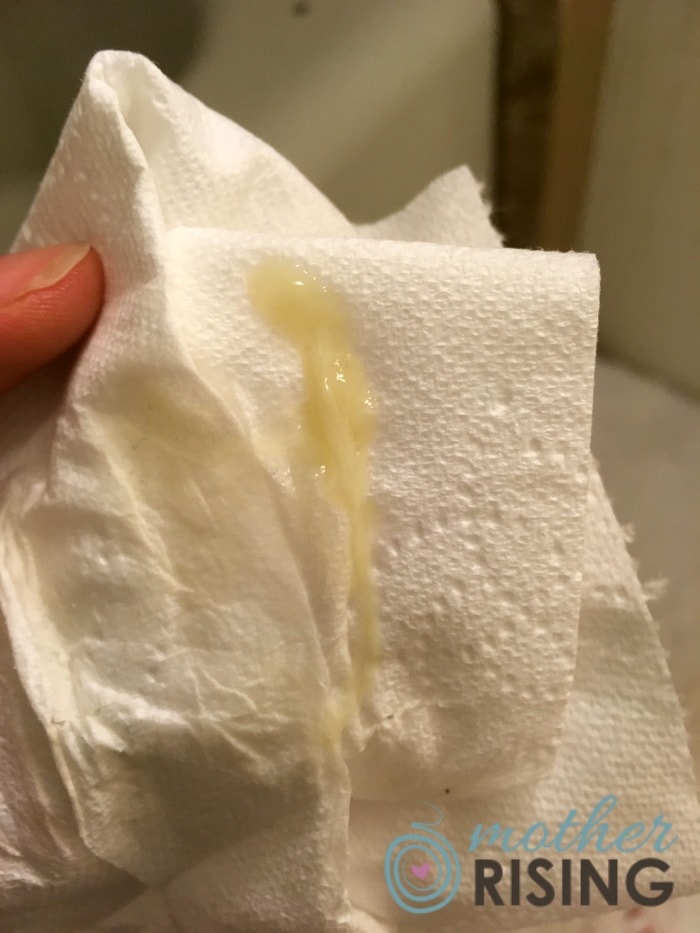


Many pain medicines have acetaminophen, which is Tylenol. Do not take two or more pain medicines at the same time unless the doctor told you to.Read and follow all instructions on the label. Take an over-the-counter pain medicine, such as acetaminophen (Tylenol) or ibuprofen (Advil, Motrin). They happen because the uterus is going back to normal size.

It's normal to have cramps for the first few days after the birth.Do not use tampons until your doctor says it's okay. This will prevent soreness and infection. Lochia Serosa: The lochia rubra gradually changes color to brown and then yellow over a period of about a week. It is made up of mainly blood, bits of fetal membranes, decidua, meconium, and cervical discharge. It is reddish in color - hence the term rubra. If you have a tear or stitches in your vaginal area, change your pad at least every 4 hours. Lochia Rubra: Lochia rubra occurs in the first 3-4 days after delivery.Don't worry if you also pass some blood clots, as long as they are smaller than a golf ball. It may last for 2 to 4 weeks or longer, until your uterus heals. After about 10 days, it will be white or yellow. Implantation bleeding tends to occur around the same time you expect your period. You might notice implantation bleeding as brown discharge when wiping after urination. As it does, it creates a small amount of bleeding. This occurs when a fertilized egg attaches to the uterine lining. In less than a week, it will be pink in colour. Brown discharge may be a sign of implantation bleeding. After the birth, you will have a bloody discharge from the vagina.You are also permissible for your husband, because Umm ‘Atiyyah (may Allaah be pleased with her) said: “We used to think that the brownish and yellowish discharge after the end of the period did not matter.” Narrated by al-Bukhaari in his Saheeh and by Abu Dawood this version narrated by Abu Dawood). Similarly, if this brownish or yellowish discharge comes after your period ends, it is not be regarded as part of the period, rather it comes under the ruling on istihaadah, so you have to wash your private parts with water and do wudoo’ for each prayer, and you should pray and fast, and not regard this as menstruation. So it does not mean that you cannot pray and fast, but it does mean that you have to do wudoo’ every time, until that discharge stops, as in the case of istihaadah (non-menstrual bleeding).īut if these five days are followed immediately by your period, then they are part of your period, so you should not fast or pray on these days. If the five days on which you have the brown discharge are separate from the days when you bleed, then this is not menstruation, and you have to pray on these days and can fast, but you should do wudoo’ for each prayer, because this comes under the same ruling as urine, not the rulings on menstruation. Symptoms that can accompany brown discharge and shouldn’t be ignored include vaginal itching, foul odor and cramping. It is also normal to have some dark discharge following sexual intercourse. I pray on the five days but I wonder whether I should fast and pray on these days or not? Please advise me, may Allaah reward you. Small amounts of brown discharge that ranges from fluid to mucus-like consistency is common, particularly in the early stages of pregnancy.

The menstrual blood lasts for eight days after the first five days. Shaykh Ibn Baaz (may Allaah have mercy on him) was asked: Before my period comes I have a brown discharge that lasts for five days, after which comes the menstrual blood. The tuhr or end of the period is indicated by one of two signs: either a clear discharge is emitted, or the place becomes dry, so that if it is wiped with a piece of cotton or something similar, it comes away clean with no trace of blood or yellowish or brownish discharge. If that happens before the tuhr, then it is part of the period if that happens after the tuhr, then it does not matter and it comes under the same ruling as the blood of istihaadah and does not mean that you cannot fast or pray, but you should do wudoo’ at the time of each prayer. Endometriosis is a condition where tissue similar to the lining of the uterus grows in places outside of the uterus, such as the ovaries and fallopian tubes. The same applies to the stringy red discharge that you see for two days. If it is separate from the bleeding, then it is not part of your period. If it is followed directly by the bleeding, then it is part of your period, so it is not permissible to pray and fast at that time. The brown and red spots that come before the period are subject to further discussion: The thick blood that is accompanied by pains for four days is undoubtedly menstruation.


 0 kommentar(er)
0 kommentar(er)
